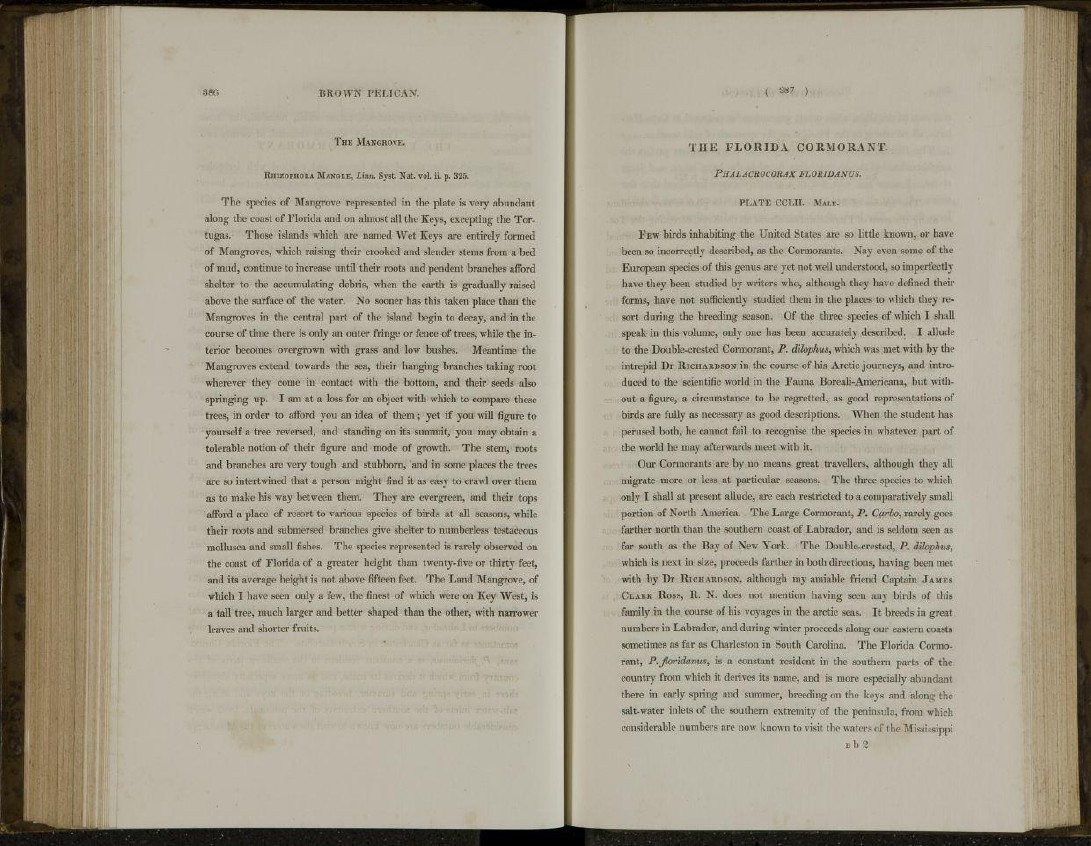
BROWN PELICAN.
THE MANGROVE.
RHIZOPHORA MANGLE, Linn. Syst. Nat. vol. ii. p. 325.
The species of Mangrove represented in the plate is very abundant
along the coast of Florida and on almost all the Keys, excepting the Tortugas.
Those islands which are named Wet Keys are entirely formed
of Mangroves, which raising their crooked and slender stems from a bed
of mud, continue to increase until their roots and pendent branches afford
shelter to the accumulating debris, when the earth is gradually raised
above the surface of the water. No sooner has this taken place than the
Mangroves in the central part of the island begin to decay, and in the
course of time there is only an outer fringe or fence of trees, while the interior
becomes overgrown with grass and low bushes. Meantime the
Mangroves extend towards the sea, their hanging branches taking root
wherever they come in contact with the bottom, and their seeds also
springing up. I am at a loss for an object with which to compare these
trees, in order to afford you an idea of them; yet if you will figure to
yourself a tree reversed, and standing on its summit, you may obtain a
tolerable notion of their figure and mode of growth. The stem, roots
and branches are very tough and stubborn, 'and in some places the trees
are so intertwined that a person might find it as easy to crawl over them
as to make his way between them. They are evergreen, and their tops
afford a place of resort to various species of birds at all seasons, while
their roots and submersed branches give shelter to numberless testaceous
mollusca and small fishes. The species represented is rarely observed on
the coast of Florida of a greater height than twenty-five or thirty feet,
and its average height is not above fifteen feet. The Land Mangrove, of
which I have seen only a few, the finest of which were on Key West, is
a tall tree, much larger and better shaped than the other, with narrower
leaves and shorter fruits.
( 387 )
THE FLORIDA CORMORANT.
PHALACROCORAX FLORIDANUS.
PLATE CCLII. MALE.
F EW birds inhabiting the United States are so little known, or have
been so incorrectly described, as the Cormorants. Nay even some of the
European species of this genus are yet not well understood, so imperfectly
have they been studied by writers who, although they have defined their
forms, have not sufficiently studied them in the places to which they resort
during the breeding season. Of the three species of which I shall
speak in this volume, only one has been accurately described. I allude
to the Double-crested Cormorant, P. dihphus, which was met with by the
intrepid Dr RICHARDSON in the course of his Arctic journeys, and introduced
to the scientific world in the Fauna BoreaH-Americana, but without
a figure, a circumstance to be regretted, as good representations of
birds are fully as necessary as good descriptions. When the student has
perused both, he cannot fail to recognise the species in whatever part of
the world he may afterwards meet with it.
Our Cormorants are by no means great travellers, although they all
migrate more or less at particular seasons. The three species to which
only I shall at present allude, are each restricted to a comparatively small
portion of North America. The Large Cormorant, P. Carlo, rarely goes
farther north than the southern coast of Labrador, and is seldom seen as
far south as the Bay of New York. The Double-crested, P. dilophus,
which is next in size, proceeds farther in both directions, having been met
with by Dr RICHARDSON, although my amiable friend Captain JAMES
CLARK ROSS, R. N. does not mention having seen any birds of this
family in the course of his voyages in the arctic seas. It breeds in great
numbers in Labrador, and during winter proceeds along our eastern coasts
sometimes as far as Charleston in South Carolina. The Florida Cormorant,
P.floridanus, is a constant resident in the southern parts of the
country from which it derives its name, and is more especially abundant
there in early spring and summer, breeding on the keys and along the
salt-water inlets of the southern extremity of the peninsula, from which
considerable numbers are now known to visit the waters of the Mississippi
Bb %